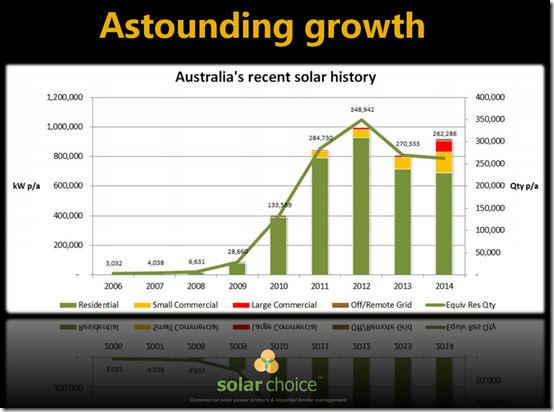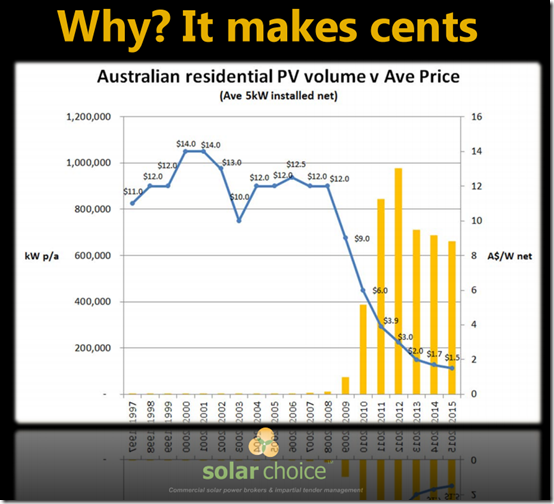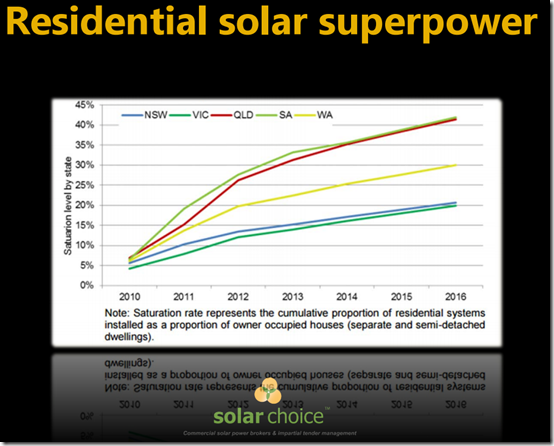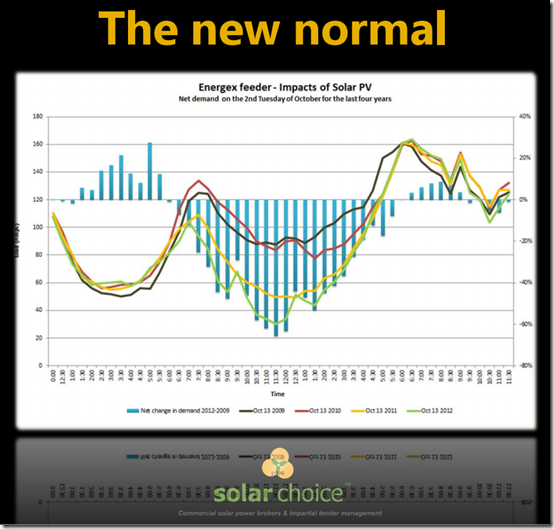Twenty something years is a long time to spend on a roller coast, especially if it’s a solar powered one.
When I started in solar all those years ago, I had a naïve ambition that solar would save me from the volatility of the automotive industry where I worked at the time. I got that kind of wrong, but there has certainly never been a dull moment on this ride.
I was recently asked to present at the Energy Users Association conference (in Brisbane in May) and used the opportunity to recap on the changes I’ve witnessed.
I spoke on behalf of my business, and for Solar Choice.
The event and audience was somewhat different to what I’m used to and I must admit, one of the more challenging gigs I’ve done. The audience included some businesses and analysts who were interested in what solar could do for them, but there were also a number of very large users and utilities who frankly, see solar as huge pain the backside.
When the solar industry was in its infancy and the very first grid connected solar system was connected in 1994 at Mt Coolum in Queensland, solar cost around $27/Watt installed. A builder at that trailblazing home site will go down in history for his scoffing comment “hmmmfph; this will never catch on”.
It may have been expensive, but it’s still working today and was a testament to what the future would look like. Only 18 months later, Australia’s first Commercial PV system was connected when a north coast business installed a 10kW, three phase PV system with wind and battery back-up for good measure. It was connected after long negotiations with an agreed export rate of $0.02c/kWh.
Fast forward twenty odd years and its getting hard to keep up with the numbers of grid connected systems which now exceeds 1.3Million. Costs are typically around $1.00-$1.50/W and although it’s been a long time between drinks, storage is coming back with a vengeance.
As I described to the audience, we have seen rebates, support and incentives come and go over the years but by 2011, a perfect storm of price reductions, favourable foreign exchange rates and hyper support sent the solar market into overdrive. When solar One was installed, annual sales in Australia were around 1MW per year and by the end of 2011 it had reached 1,000MW per year and cumulative capacity has grown from around 8MW to more than 4,000MW.
Growth, support, rebates and incentives have a cost of course and I was left under no illusion as to what this meant to some energy consumers by the speaker preceding me at the Energy Users Association conference. “The RET is a massive challenge because of the wealth transfer” was my take on the core of his message.
The previous speaker walked off the stage and I took to the podium with my presentation about “how awesome solar was”.
Awkward.
I stuck to my story but focused on the truth that there are undoubtedly winners and losers in every market and acknowledged that the revolutionary change that has been happening has created challenges for some business sectors.
1) I highlighted that during many of these politically motivated incentives, the solar industry had actually argued against excessive support. We could see that hyper support would create a bubble (with associated problems resulting from that) but politely said thank you and got on with the job once the decisions was made.
2) On the other hand, we have also come out ferociously in defence of support where the changes were considered too harsh, too abrupt and the consequences ignored.
Today, putting aside the legacy costs of FIT’s, the solar industry effectively has a single support mechanism which is the Renewable Energy Target. Some argue that its cost is too high as a subsidised abatement measure. We will of course argue that subsidies and wealth transfers exist across a huge array of sectors and that comparatively, we still receive relatively little.
We will make the point again, that there are costs and benefits to society with solar, as there are with the prolific uptake of air-conditioning, for example.
The simple fact of the matter that I highlighted to my audience is this; Solar is massively popular if you are an energy user although it clearly works better for some than others. Tens of thousands of businesses are using it along with millions of homeowners and whilst there will continue to be ups and downs, there are no brakes on this ride because costs are headed in one direction.
Around 5 million Australian’s live or work under a solar roof today and not understanding their enthusiasm and passion for solar will only end in pain. Compared to other interest groups, solar owners are extraordinarily engaged and protective of their beloved, bill reducing solar panels.
At the macro level, the evolution of regulatory change to adapt to distributed rather than centralised energy architecture won’t come easily. But it will come, as long as consumers naturally continue to want more control over their energy costs.
The hype around storage is quickly turning to real sales, too, and will add an exciting new dimension to the re-invention of the energy market.
The naysayers will tell you it’s too expensive and doesn’t make an adequate return and is fraught with dangers and to some degree I actually agree. However, this assumes that consumers are rational and of course, they aren’t. They are emotional and react quickly, sometimes spontaneously to technology and things that ease the pain of daily life or improve their bottom line in business.
If there is one thing that twenty years on the solar coaster has taught me it is this; when you do a half decent forward forecast about new technology uptake you will inevitably look back in ten years and realise you were no-where near optimistic enough.
The builder at Solar One was wrong twenty years ago and personally, it’s my view that the solar haters are wrong too.
It’s not a matter of if; it’s only a matter of when.
Editor’s Note
Nigel Morris spoke on this topic at the EUAA Queensland Energy Forum in May – in a session that also included a presentation by Miles Prosser on “the RET Joyride” (which Miles later wrote about on WattClarity here).
Given the wide-reaching implications of policies in this space both of these speakers were invited to post their thoughts on WattClarity.
About our Guest Author
| Nigel Morris has been involved in solar energy for more than 20 years and is the founder of Solar Business Services & Moto-Electro.
He has worked for small solar companies as an installer, designer and salesman of solar and storage systems. He has worked for International solar manufacturers in a variety of senior sales and business development positions and helped deploy thousands of solar systems around the world, including some highly prestigious projects. Five years ago, Nigel founded Solar Business Services, an award winning and highly respected solar consultancy. The company provides business coaching for small solar company’s, advises some of the world’s largest solar corporations on strategy and conducts leading research for industry and Government. You can find Nigel on LinkedIn here. Recently he also formed Moto-Electro to help accelerate the use and grid integration of electric motorcycles. Nigel sits on a number of advisory boards in the solar industry, is a prolific blogger and an enthusiastic advocate for the solar industry and electric transport. |








We’ve been subsidising solar for 45 years at least. The subsidies for production should cease. It cannot be justified.
I recall Dr Mark Diesendorf, Dr David Mills and Dr Stephen Kaneff in about 1991 arguing that “solar is baseload capable and cheaper than nuclear now, if the stupid government would just give us more money to demonstrate it.
That was 24 years ago. But still solar is not viable. Solar is still hopelessly uncompetitive and all investment would stop if not for the subsidies and regulatory incentives to prop it up.
Don’t make me laugh. We’ve been subsidising nuclear for even longer, and at higher cost, with worse results.
Residential solar is the cheapest consumer fuel -without certificates. That should be your argument to cease subsidies.
Nuclear costs more than solar even when run at 95% capacity factor. When nuclear does load following it can’t compete with diesel let alone anything else. Leave nukes to those without any other resources.
Tom,
As usual you don’t have a clue what you are talking about. if you want to compare subsidies for different technologies you have to normalise – i.e. show the subsidy per unit of energy supplied through the the plants life. The subsidies for solar are an order of magnitude higher than for nuclear.
We got a return on investment with solar, look at the second graph. Nuclear subsidies per MWh are rising.
Nuclear $180/MWh, Solar $100/MWh. What don’t you get here? It costs more to subsidise nuclear.
Having a hard-on for nuclear power doesn’t constitute some form of expertise.
“Having a hard-on for nuclear power doesn’t constitute some form of expertise.”
Word, Tom.